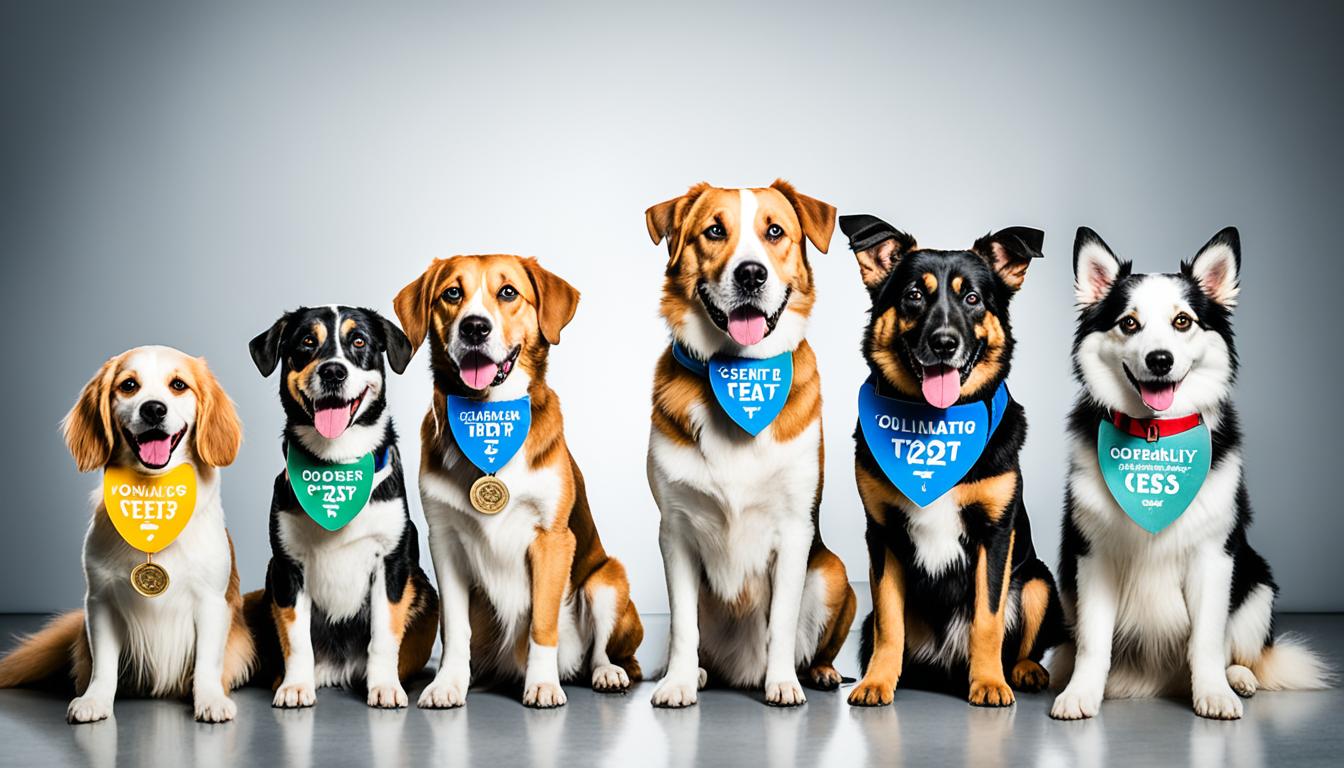Top Easiest Dog Breeds to Train – Quick Guide
Training a dog can be a rewarding and enjoyable experience, but some breeds are easier to train than others. Factors like intelligence, breed purpose, desire to please, temperament, and energy levels contribute to a breed’s trainability. In this comprehensive guide, we’ll explore the top easiest dog breeds to train, known for their intelligence, willingness to please, and adaptability.
Key Takeaways:
- The easiest dog breeds to train possess high intelligence and a strong desire to please.
- Training success is influenced by factors such as breed purpose, temperament, and energy levels.
- Consistency, patience, and positive reinforcement are essential for successful dog training.
- Seeking professional guidance can be helpful, especially for first-time owners.
- Individual variation exists within each breed, necessitating a personalized approach to training.
Why Some Breeds Are Easier to Train Than Others
When it comes to training dogs, not all breeds are created equal. The trainability of a dog breed can be influenced by a combination of factors that affect their ability to learn and follow commands. Understanding these factors can help owners make informed decisions when choosing a breed that is more receptive to training.
One of the key factors that plays a significant role in trainability is intelligence and problem-solving abilities. Some breeds possess a high level of intelligence, making it easier for them to understand and execute commands. These dogs are quick learners and can pick up new skills with minimal effort. On the other hand, breeds with lower intelligence may require more time and effort to grasp and retain training concepts.
Breed purpose is another crucial aspect that contributes to trainability. Breeds that were originally bred for specific tasks, such as herding or hunting, often have a natural inclination to follow instructions and work alongside their owners. Their innate abilities and instincts make training them for their intended purpose relatively easier.
The desire to please their owners is also an important trait that impacts a dog’s trainability. Certain breeds have a strong desire to make their owners happy and seek their approval. These dogs are highly motivated to please and are more likely to excel in training sessions. On the other hand, breeds with independent personalities may be less inclined to seek approval and may require different training methods that suit their individual needs.
Temperament and personality play a significant role in a dog’s trainability as well. Calm and attentive breeds are often easier to train compared to highly energetic and easily distracted breeds. A dog with a stable temperament is more likely to focus and respond well to training, while a more excitable or anxious dog may require additional training techniques to help them stay focused.
The energy levels of a breed can also impact trainability. Breeds with high energy levels may need more physical and mental stimulation to maintain focus during training sessions. Adequate exercise and mental enrichment can help these dogs channel their energy in a positive way, making training sessions more effective.
Socialization and environment also play crucial roles in a dog’s trainability. Proper socialization during the early stages of a dog’s life helps them develop confidence and adaptability, making them more receptive to training. A supportive and consistent training environment that is free from distractions can also contribute to better training outcomes.
The handler’s training skill and consistency are essential for successful training. A knowledgeable handler who can effectively communicate with their dog and provide clear instructions is more likely to achieve positive training results. Consistency in training methods and expectations is key to reinforcing desired behaviors and ensuring the dog understands what is expected of them.
Breed-specific traits, such as instinctual behaviors, can influence trainability as well. For example, breeds with a strong prey drive may require additional training and management to prevent them from chasing small animals. Understanding these breed-specific traits can help owners anticipate challenges and tailor their training approach accordingly.
Lastly, motivation and reinforcement are vital for successful training. Finding what motivates a dog, whether it be treats, praise, or play, and using positive reinforcement techniques can make the training process more enjoyable and effective. Consistently rewarding desired behaviors encourages dogs to repeat those behaviors and reinforces the learning process.
It’s worth noting that some factors influencing trainability may have a genetic component. Certain breeds may have a predisposition for certain traits that impact trainability, such as heightened problem-solving abilities or a strong desire to please. However, it’s important to remember that individual variation exists within every breed, and each dog is unique in their trainability.
By considering these various factors and understanding the trainability of different breeds, owners can make informed decisions when selecting a dog that aligns with their training goals and capabilities.
Top 10 Easiest Dog Breeds to Train
Training a dog can be a fulfilling experience, especially when you have a highly trainable and easy-to-train dog breed. These intelligent and adaptable canine companions are known for their quick grasp of commands, eagerness to please, and excellent trainability. If you’re looking for a dog that will make the training process smoother and more enjoyable, consider these top 10 easiest dog breeds:
| Breed | Traits |
|---|---|
| Labrador Retriever | Intelligent, friendly, and obedient |
| German Shepherd | Highly trainable, loyal, and protective |
| Golden Retriever | Intelligent, friendly, and eager to please |
| Poodle | Highly intelligent, trainable, and versatile |
| Border Collie | Extremely intelligent, obedient, and athletic |
| Doberman Pinscher | Intelligent, loyal, and protective |
| Shetland Sheepdog | Intelligent, trainable, and agile |
| Labradoodle | Smart, trainable, and hypoallergenic |
| Australian Shepherd | Intelligent, energetic, and obedient |
| Papillon | Smart, alert, and eager to learn |
These dog breeds have consistently shown high levels of trainability, making them ideal choices for first-time owners or those looking for a companion that can quickly grasp obedience commands. Whether you’re aiming for basic obedience training or more advanced tasks, these breeds will impress you with their ability to learn and adapt to different training methods.
Remember, while these breeds are highly trainable, it’s crucial to approach training with patience, consistency, and positive reinforcement. Each dog has its own unique personality, so tailor your training approach to suit their individual needs. Celebrate their successes and always make training a positive and rewarding experience!

Training Tips for Success
When it comes to successful dog training, a few key tips can make all the difference. By incorporating positive reinforcement, consistency, and patience into your training routine, you can help your dog learn and develop good behaviors.
First and foremost, positive reinforcement is a powerful tool in training your dog. Rewarding desired behaviors with treats or praise helps reinforce those behaviors, encouraging your dog to repeat them. This method creates a positive association with training and motivates your dog to learn.
Consistency is another crucial element in successful training. Dogs thrive on routine and repetition, so it’s important to establish consistent training methods and commands. This helps your dog understand what is expected of them and reduces confusion. Stick to the same cues and commands, using clear and concise language, to reinforce their understanding.
Patience is key when training a dog. Each dog learns at their own pace, so it’s important to remain patient and avoid becoming frustrated. Training takes time and repetition, so embrace the process and celebrate small victories along the way. Remember that dogs respond best to positive and patient training methods.
Seeking Professional Guidance
If you find yourself struggling with training or facing particular challenges, don’t hesitate to seek guidance from a professional dog trainer. They have the knowledge and experience to provide personalized training techniques and solutions tailored to your dog’s specific needs. A professional trainer can also offer valuable advice and support to help you navigate any training difficulties.
With the right training techniques and consistency, your dog will develop the skills and behaviors you desire. Training should be a positive and rewarding experience for both you and your furry friend, strengthening the bond between you. So be patient, embrace positive reinforcement, and enlist professional help when needed, and success will surely follow.

Individual Variation in Trainability
When it comes to dog training, it’s crucial to recognize that individual variation exists within every dog breed. Each dog has its own unique personality, learning style, and preferences. This means that a one-size-fits-all approach to training simply does not work. To achieve the best results, it’s essential to adopt a personalized training approach that considers the specific needs and abilities of each dog.
By tailoring training methods to suit the individual dog, we can address dog training differences and effectively address their strengths and weaknesses. Some dogs may respond well to positive reinforcement, while others may require a more assertive and firm approach. Understanding and adapting to the individual variations in trainability can lead to greater success and a stronger bond between the owner and their furry companion.
As we embark on the journey of training our dogs, we must keep in mind that a personalized training approach ensures that the training program is aligned with the unique characteristics and preferences of our canine companions. This level of customization optimizes the training experience and promotes better engagement, allowing for a pleasant and effective learning process.
Benefits of a Personalized Training Approach
A personalized training approach offers several advantages:
- Enhanced learning: By tailoring the training methods to suit the dog’s individual needs, we can optimize their learning experience. This leads to quicker and more efficient results.
- Improved motivation: When dogs receive training that aligns with their preferences and abilities, they become more motivated and enthusiastic, making the training sessions more enjoyable for both the dog and the owner.
- Stronger bond: A personalized training approach fosters a deeper connection between the owner and their dog. By understanding and catering to the dog’s unique characteristics, we establish trust and strengthen the bond that forms the foundation of a harmonious relationship.
- Effective problem-solving: Each dog may encounter different challenges and obstacles during training. A tailored approach allows us to address these challenges more effectively, adapting our methods to overcome any hurdles that arise.
Personalization in Action
Let’s take a look at how a personalized training approach can be implemented:
“My Labrador Retriever, Max, is a highly energetic and intelligent dog. To cater to his individual needs, I incorporate plenty of physical exercise and mental stimulation into his training routine. I’ve found that using interactive toys and puzzles, combined with positive reinforcement, helps keep him engaged and focused during training sessions. By recognizing his individual variation in terms of energy levels and intelligence, I can provide him with an optimal training experience.”
As seen in the example above, understanding and addressing individual variation in trainability leads to a training program that is tailored to the specific needs, preferences, and abilities of the dog. This personalized training approach sets dogs up for success and allows them to reach their full potential.
Conclusion
Training a dog can be a highly rewarding and enjoyable experience, and choosing the right breed can make the process even easier. The top trainable dog breeds are highly intelligent, willing to please, and adaptable, making them ideal candidates for successful dog training.
By understanding the factors that contribute to a breed’s trainability, such as intelligence, temperament, and energy levels, dog owners can set realistic expectations and tailor their training approach accordingly. Following effective training tips, including positive reinforcement, consistency, and patience, can further enhance the training process.
Whether you are a first-time owner or looking to add a new furry friend to your family, selecting one of the easiest dog breeds to train can lead to quick and effective obedience training success. These highly trainable dogs are known for their ability to learn and respond well to commands, making them a joy to train and a cherished companion for years to come.
FAQ
What factors contribute to a dog breed’s trainability?
The ease of training in dogs can be influenced by a combination of factors like intelligence and problem-solving abilities, breed purpose, desire to please, temperament, energy levels, socialization and environment, handler’s training skill and consistency, breed-specific traits, motivation and reinforcement, and genetic predispositions.
How can I train my dog effectively?
When training a dog, it’s important to be patient, consistent, and use positive reinforcement. Setting aside dedicated time for training sessions, seeking professional help if needed, and using treats as rewards can all contribute to successful training. Consistency in training methods and commands is also key to reinforcing desired behaviors.
Are all dogs within a breed equally trainable?
It’s important to acknowledge that individual variation exists within every dog breed when it comes to trainability. Each dog has its own unique personality, learning style, and preferences. This calls for a personalized approach to training, considering the specific needs and abilities of each dog. Tailoring training methods to suit the individual dog can lead to better results and a stronger bond between the owner and their pet.
What are the easiest dog breeds to train?
The top easiest dog breeds to train are highly intelligent, willing to please, and adaptable. These breeds include Border Collies, Poodles, German Shepherds, Golden Retrievers, Labrador Retrievers, Australian Shepherds, Shetland Sheepdogs, Papillons, Doberman Pinschers, and Cavalier King Charles Spaniels.
Can a first-time dog owner easily train a dog?
Yes, with the right breed choice and commitment to training, a first-time dog owner can successfully train a dog. It’s important to choose a breed known for its trainability and to be consistent and patient with the training process. Seeking professional help or attending obedience classes can also provide guidance and support for first-time owners.
How can I best house train my dog?
House training a dog requires consistency, a set schedule for bathroom breaks, positive reinforcement for desired behaviors, and supervision to prevent accidents. Crate training can also be an effective method for house training, as it teaches the dog to associate their crate with a safe and clean space.







